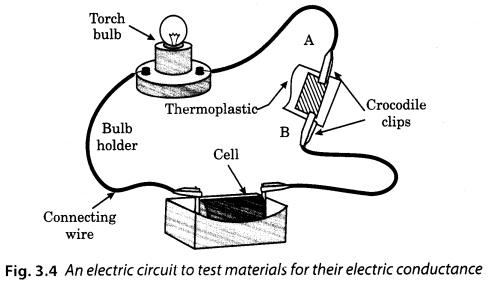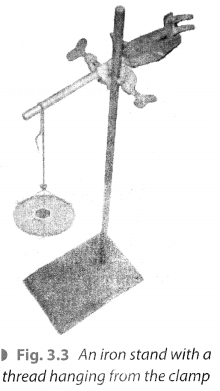Question 1.
Explain why some fibres are called synthetic.
Some fibres are called synthetic fibres because they are made by man using chemicals.
Question 2.
Mark (✓) the correct answer.
Rayon is different from synthetic fibres because
(a) it has a silk-like appearance.
(b) it is obtained from wood pulp.
(c) its fibres can also be woven like those of natural fibres.
(b) it is obtained from wood pulp.
Question 3.
Fill in the blanks with appropriate words.
(a) Synthetic fibres are also called ____ or ____ fibres.
(b) Synthetic fibres are synthesised from a raw material called _____
(c) Like synthetic fibres, plastic is also a _____
(a) man-made, artificial fibres
(b) petrochemicals
(c) polymer
Question 4.
What are the advantages of nylon ?
Nylon fibre is strong, elastic and light. It is lustrous and easy to wash.
Question 5.
Explain why plastic containers are favoured for storing food
Plastic containers are favoured for storing food because of the following reasons:
(i) the plastics do not react with the food stored in them.
(ii) the plastics are lightweight and are strong.
(iii) they are easy to handle and safe.
Question 6.
Explain the difference between thermoplastic and thermosetting plastics.
| Thermoplastics | Thermosetting plastics |
| (i) These plastics softened on heating and can be bent easily. | (i) These plastics when moulded once, can’t be softened again. |
| (ii) They do not lose their plasticity. | (ii) They lose their plasticity. |
| (iii) Examples are polyethene, PVC, etc. | (iii) Examples are bakelite and melamine. |
Question 7.
Explain why the following are made of thermosetting plastics.
(a) Saucepan handles
(b) Electric plugs/switches/plugboards
(a) Since, thermosetting plastics are a bad conductor of heat and do not get heated up while cooking, they are used for making saucepan handles.
(b) Since thermosetting plastics are a bad conductor of electricity and the electric current does not pass through such plastics, they are used for making electric plugs/switches/plugboards.
Question 8.
Categorise the materials of the following products into ‘can be recycled’ and ‘can not be recycled’.
Telephone instruments, plastic toys, cooker handles, carry bags, ballpoint pens, plastic bowls, plastic covering on electrical wires, plastic chairs, electrical switches.
| Can be recycled | Cannot be recycled |
| Plastic toys carry bags, plastic bowls, plastic covering on electrical wires, plastic chairs. | Telephone instruments, cooker handles, ballpoint pens, electrical switches. |
Question 9.
Rana wants to buy shirts for summer. Should he buy cotton shirts or shirts made from synthetic material? Advise Rana, giving your reason.
He should buy cotton shirts. This is because cotton has more capacity to hold moisture than synthetic clothes. In summers we have extensive sweating which is easily soaked by cotton shirts and hence, cotton clothes are much better than the clothes made from synthetic material.
Question 10.
Give examples to show that plastics are non-corrosive in nature.
The literal meaning of non-corrosive is resistant to get destroyed by chemical action.
Following are the examples that show that plastics are non-corrosive in nature.
- Plastic containers do not react with items stored in it.
- They do not get rusted when exposed to moisture and air.
- They do not decompose when left in open for a long period.
Question 11.
Should the handle and bristles of a toothbrush be made of the same material? Explain your answer.
Lorem ipsum dolor sit amet, consectetur adipiscing elit. Ut elit tellus, luctus nec ullamcorper mattis, pulvinar dapibus leo.
Question 12.
‘Avoid plastics as far as possible’. Comment on this advice.
Plastics must be avoided as far as possible. The materials made of plastics are non-biodegradable. The use of plastics has a bad effect on the environment. When the plastics are burnt, it releases a lot of poisonous fumes into the atmosphere causing air pollution. These plastic materials when eat up by the animals (like cows), choke their respiratory system. This can cause death of these animals. The waste plastic articles thrown here and there carelessly get into dirty water drains and sewers, and block them. In a nutshell, plastics can be considered a threat to our environment.
Question 13.
Match, the terms of column A correctly with the phrases given in column B.
| A | B |
| (i) Polyester | Prepared by using wood pulp |
| (ii) Teflon | Used for making parachutes and stockings |
| (iii) Rayon | Used to make non-stick cookware |
| (iv) Nylon | Fabrics do not wrinkle easily |
(i) (d)
(ii) (c)
(iii) (a)
(iv) (b)
Question 14.
‘Manufacturing synthetic fibers is actually helping the conservation of forests’. Comment.
In the manufacturing of synthetic fibers, we use only chemical substances and no natural materials, thus, in turn, we conserve forests.
Question 15.
Describe an activity to show that thermoplastic is a poor conductor of electricity.

It is observed that the bulb does not glow. This shows that thermoplastic is a poor conductor of electricity.
Take an iron stand with a clamp. Take a cotton thread of about 60 cm in length. Tie it to the clamp so that it hangs freely from it as shown in Fig. 3.3.

At the free end suspend a pan so that weight can be placed in it. Add weight one by one till the thread breaks. Note down the total weight required to break the thread. This weight indicates the strength of the fiber. Repeat the same activity with threads of wool, polyester, silk, and nylon. Tabulate the data as shown in Table 3.1. Arrange the threads in order of their increasing strength.
Observation Table 3.1
| S. No. | Type of Thread/ Fibre | Total Weight required to break the thread |
| 1. | Cotton | 12 gm |
| 2. | Wool | 70 gm |
| 3. | Silk | 50 gm |
| 4. | Nylon | 100 gm |
Question 16.
Explain why some fibres are called synthetic.
Some fibres are called synthetic because they are made by human beings.
Question 17.
Mark the correct answer.
Rayon is different from synthetic fibres because
- It has a silk-like appearance.
- It is obtained from wood pulp.
- Its fibres can also be woven like those of natural fibres.
- It is obtained from wood pulp.
Question 18.
Give examples which indicate that nylon fibres are very strong.
Parachutes and nylon ropes are used for rock climbing.
Question 19.
Name the plastic whose sheets are used for packing liquids.
Polythene.
Question 20.
Why is teflon used as tape for sealing purpose ?
Becausee of its toughness, teflon is used as tape for sealing purpose.
Question 21.
Name the first fully synthetic fibre.
Nylon.
Question 22.
Why nylon is used for making parachutes ?
Nylon is used for making parachutes, because it is very strong, elastic and light.
Question 23 .
Name the material used for making ropes for rock climbing.
Lorem ipsum dolor sit amet, consectetur adipiscing elit. Ut elit tellus, luctus nec ullamcorper mattis, pulvinar dapibus leo.
Question 24.
What is polyester ?
Polyester is made up of the repeating units of an ester.
Question 25.
Name the plastic used for making polythene bags.
Polythene bag is made of plastic which is a polymer of ethene.
Question 26.
What name is given to plastics which can be re-set a number of times ?
Thermoplastics.
Question 27.
Classify the following into thermosetting and thermoplastics-combs, bakelite, melamine, toys.
Thermosetting – bakelite, melamine
Thermoplastics – combs, toys
Question 28.
Why are the chemicals in the laboratory stored in plastic containers ?
Plastics are non-reactive, so they can be used for storing chemicals.
Question 29.
Can you store pickles in plastic containers ? Why ?
Plastics are non-reactive, so pickles can be stored in them.
Question 30.
Why are the electric wires covered with plastic ?
Lorem ipsum dolor sit amet, consectetur adipiscing elit. Ut elit tellus, luctus nec ullamcorper mattis, pulvinar dapibus leo.
Question 31.
Why do we use plastic cookwares in microwave ovens ?
We use plastic cookware in microwave ovens, because they are not affected by heat but the food is cooked.
Question 32.
Tin takes about 100 years to degenerate. Is it biodegradable or non-biodegradable ?
Tin is non-biodegradable.
Question 33.
Is it advisable to use recycled plastic containers for storing food ?
No, we should not use recycled plastic containers for storing food because they contain colouring agents.
Question 34.
As a responsible citizen, what are the 4R’s we should remember ?
Reduce, Reuse, Recycle and Recover.
Question 35.
Aperson has to make a non-stick pan. He has three types of plastic-Bakelite, Teflon and PVC. Which plastic will he use for coating and why ?
The person will use Teflon because it is not affected by heat and does not react chemically with other substances.
Question 36.
Explain the difference between thermoplastic and thermosetting plastics.
ThermosettingThermoplastic(i) These plastics can be moulded and
(ii) e.g.,Bakelite and melamine.(i) These plastics can be moulded and reset a number of times.
(ii) e.g. Polythene and PVC.
Question 37.
Differentiate between natural and synthetic fibres.
Natural fibres are obtained from nature, e.g., cotton whereas synthetic fibres are made by man, e.g., nylon.
Question 38.
How is rayon made ? Give one advantage of using rayon.
Rayon is obtained from wood pulp by treating it chemically. It is cheaper than silk, but can be woven like silk fibre.
Question 39.
Is nylon fibre so strong, that we can use it to make parachutes ?
Yes, nylon is very strong and it can be used for making parachutes.
Question 40.
Give some uses of PET.
PET is used for making bottles, utensils, fibres and wires.
Question 41.
Give the composition of Polycot and Polywool.
Polycot is a mixture of polyester and cotton, Poly wool is a mixture of polyester and wool.
Question 42.
What properties of plastics make it useful for many things ?
Plastics can be recycled, reused, coloured, melted, rolled into sheets or made into wires, so they are very useful.
Question 43.
Why is melamine used for making kitchenware ?
Melamine resists fire and can tolerate heat better than other plastics. So, it is used for making kitchenware.
Question 44.
Buckets made up of plastics are better. Why ?
Buckets made up of plastic are better because they are light, strong and durable.
Question 45.
Differentiate between biodegradable and non-biodegradable materials.
| Biodegradable Materials | Non-biodegradable Materials |
| (i) A material that gets decomposed through natural processes, such as the action of bacteria. (ii) e.g., cotton or jute. |
(i) A material which does not get decomposed by natural processes. (ii) e.g., plastics. |
Question 46.
Should the handle and bristles of a toothbrush be made of the same material? Explain your answer.
No, the handle and bristles of a toothbrush cannot be made of the same plastic. The handle is hard but the bristles are soft and flexible.
Question 47.
Give three advantages of polythene over natural materials.
Three advantages of polythene over natural materials are :
- It is strong but flexible.
- Can be rolled into sheets.
- Water resistant.
Question 48.
Give one use each of bakelite, nylon and acrylic.
Bakelite is used for making plugs and switches. Nylon is used in textile industry to produce clothes. Acrylic is used as a substitute of natural wool for knitting sweaters, blankets etc.
Question 49.
Fill in the blanks with appropriate words.
- Synthetic fibres are also called ……….. or ……….
- Synthetic fibres are synthesised from raw material called …………
- Like synthetic fibres, plastic is also a …………..
- artificial, man-made
- mono or petrochemicals
- polymers.
Question 50.
Explain why plastic containers are favoured for storing food.
Food can be stored in plastic containers because
- Plastics are non-reactive.
- Plastics are light and strong.
- Plastics are durable.